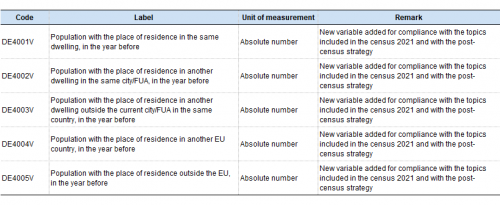City statistics – demography
Planned article update: October 2024
Highlights
This chapter of the City statistics manual provides the definitions that should be used for compiling data at city and functional urban area level in the following sub-domains: Population by age and sex, Citizenship and country of birth, Household structure and Place of usual residence the year prior to the reference date. In order to ensure comparability across countries, the recommended concepts and definitions are in line with the existing EU Regulations in different statistical domains. Concepts and definitions regarding discontinued variables are not included in the chapter.
Full article
Population by sex and age
Variables:
Population by sex and five years age groups (DE1001V to DE1139V): Population at its usual residence at the reference date. 'Usual residence’ means the place where a person normally spends the daily period of rest, regardless of temporary absences for purposes of recreation, holidays, visits to friends and relatives, business, medical treatment or religious pilgrimage or, in default, the place of legal or registered residence. The following persons alone are considered to be usual residents of the geographical area in question:
(i) those who have lived in their place of usual residence for a continuous period of at least 12 months before the reference date; or
(ii) those who arrived in their place of usual residence during the 12 months before the reference date with the intention of staying there for at least one year.
Where the circumstances described in point (i) and (ii) cannot be established, ‘usual residence’ can be taken to mean the place of legal or registered residence.
Sources:
- Regulation (EU) No 1260/2013 of the European Parliament and of the Council of 20 November 2013 on European demographic statistics.
- Commission Implementing Regulation (EU) No 205/2014 of 4 March 2014 laying down uniformed conditions for the implementation of Regulation (EU) No 1260/2013 of the European Parliament and the Council on European demographic statistics, as regards breakdowns of data, deadlines and data revisions.
It is stressed that this population number is the reference for measuring the general size of the urban entity within the specified boundaries of the city and the functional urban area (FUA). It is the denominator for most derived indicators.
Age: It is expressed as the number of birthday anniversaries passed on the date of reference. As it is the same as the number of completed years lived by a person, it is also referred to as 'age in completed years'. For many variables, there are age thresholds (population groupings; single parent households; households with children; pensioner households). The current practice or the legal frameworks differ in many countries. For reasons of comparability and in line with the EU legislation on the 2021 population and housing censuses data broken by 5 years age groups are being collected.
Reference date for population data: In European demographic statistics (national and regional level) data referring to population on 31st December of the reference year are transmitted by the Member States to Eurostat under the Regulation (EU) No 1260/2013 of the European Parliament and of the Council of 20 November 2013. The data are conventionally published by Eurostat as 1 January of the following year (reference year + 1).
The European City Statistics follow the same principle. Eurostat aims to collect data on population on 1st January of the year in question (or in some cases, on 31st December of the previous year). For census years, the reference date of the census could be used. This should be indicated in a footnote giving the exact date.
Median age (DE1073V) is the age that divides a population into two groups that are numerically equivalent.
Population by country of birth and citizenship
Variables
The term 'nationals' is used referring to the concept of citizenship.
National (national citizen) is a person who has citizenship of the reporting country.
Foreigner (non-national) is a person who does not have the citizenship of the country.
EU foreigner (citizens of another EU Member State) is a person who does not have the citizenship of the reporting country but has citizenship of another EU Member State.
Non-EU foreigner (citizens of a non-EU country/non-EU citizens) is a person who does not have the citizenship of the reporting country but has citizenship of another country outside the European Union.
A person with two or more citizenships shall be allocated to only one country of citizenship, to be determined in the following order of precedence:
1. reporting country; or, if the person does not have citizenship of the reporting country;
2. another EU Member State; or, if the person does not have citizenship of another EU Member State;
3. another country outside the European Union.
Where a person has two or more citizenships of EU Member States but where neither is the reporting country, Member States shall determine which is to be the country of citizenship.
Third-country national means any person who is not a citizen of the Union within the meaning of Article 17(1) of the Treaty, including stateless persons.
Legal reference: Regulation (EC) No 0862/2007 of the European Parliament and of the Council of 11 July 2007 on Community statistics on migration and international protection and repealing Council Regulation (EEC) No 311/76 on the compilation of statistics on foreign workers.
Commission Regulation (EU) No 351/2010 of implementing Regulation (EC) No 862/2007 on Community statistics on migration and international protection as regards the definitions of the categories of the groups of country of birth, groups of country of previous usual residence, groups of country of next usual residence and groups of citizenship.
'Recognised non-citizens' are persons who are not citizens of the reporting country nor of any other country, but who have established links to that country including some but not all rights and obligations of full citizenship. This category is particularly relevant in the Baltic States. In the case of Latvia, the government issues a particular category of non-citizen (non-EU) passport to these people. These should be counted as 'Non-EU'.
The cases of 'Unknown citizenship' should be counted as 'Non-EU'.
EU countries: 27 member countries of the European Union.
Non-EU countries should not include their own citizens in the figures for DE2003V.
For further details on citizenship, see Commission Implementing Regulation (EU) No 205/2014 of 4 March 2014 laying down uniformed conditions for the implementation of Regulation (EU) No 1260/2013 of the European Parliament and of the Council of 20 November 2013 on European demographic statistics.
Household structure
Variables:
Private household (DE3001V)
Countries use different concepts of the private household. In City Statistics, in order to enable the extensive use of registers, we choose to use the household-dwelling concept.
The recent recommendation for the 2021 census states that the housekeeping unit concept should be used. However, this concept requires non-register based census data, which is seldom available and therefore the household-dwelling concept was selected instead. Whether a country uses the 'housekeeping unit' or the 'household-dwelling' concept of a household, generally has little implication for the total number of private households. However, differences can be large for certain household types, for example for one-person households. In view of international comparability, it is therefore recommended that countries that use the 'housekeeping unit' concept, if possible, make an estimate of the number of private households according to the 'household-dwelling' concept, and break this number down by household size. Information on which concept has been used should be provided in the metadata file. Usually the household-dwelling concept is used in the case of register-based data, while surveys are the source for housekeeping unit data.
According to the 'housekeeping concept', a private household is either:
- (a) A one-person household that is a person who lives alone in a separate housing unit or who occupies, as a lodger, a separate room (or rooms) of a housing unit but does not join with any of the other occupants of the housing unit to form part of a multi-person household as defined below; or
- (b) A multi-person household that is a group of two or more persons who combine to occupy the whole or part of a housing unit and to provide themselves with food and possibly other essentials for living. Members of the group may pool their incomes to a greater or lesser extent.
This concept does not assume that the number of private households is necessarily equal to the number of housing units.
The household-dwelling concept considers all persons living in a housing unit to be members of the same household, such that there is one household per occupied housing unit. In the household-dwelling concept, then the number of occupied housing units and the number of households occupying them are equal, and the locations of the housing units and households are identical.
Households should only be generated if the respective housing unit is the usual (or legal main) residence of at least one occupant. Only persons with their main residence in a housing unit should be included in the generation of the household as defined by this housing unit.
For more information, see the EU legislation on the 2021 population and housing censuses, Explanatory notes, 2019 edition.
Lone parent private household (with children aged 0 to under 18) (DE3005V): A one family household with only one adult and at least one child under 18 years old. It should be noted that the adult is not necessarily a biological parent but an adult of the family nucleus.
Lone pensioner household (DE3008V): Single person household where that person is aged 65 or more. This definition has been changed (after consultation with the National Statistical Institutes) as the national retirement age varies in different countries.
Households with children aged 0 to under 18 (DE3011V): A private household (one family household or two or more families households) with one or more adults (over 18 years old) and at least one child (under 18 years old).
Please note: in non-Census years, the preferred data source for the variables related to the household structure is the Labour Force Survey (LFS) as the survey with the largest sample as well as administrative sources.
Place of residence
Place of usual residence one year prior to the reference date of reporting
Variables:
Variables from DE4001V to DE4005V will be correctly allocated to the requested breakdown categories if:
- the reference period starts exactly one year before the reported reference date and ends with that reference date;
- children aged less than one year must be excluded, therefore the total of variables from DE4001V to DE4005V will not be equal to the total population;
- if there has been more than one move in the reference period, the most recent move to the current city/FUA of usual residence should be considered;
- a move within the same city must also be considered as a ‘move within the same FUA as the current usual residence’.
Direct access to
Database
- City statistics (urb), see:
- Cities and greater cities (urb_cgc)
- Functional urban areas (urb_luz)
- Perception survey results (urb_percep)
Dedicated section
Publications
Methodology
Legislation
Visualisations
External links




